
a collection of notes on areas of personal interest
- Introduction
- Arabic / Islamic design
- Arabic / Islamic geometry 01
- Arabic / Islamic geometry 02
- Arabic / Islamic geometry 03
- Arabic / Islamic geometry 04
- Islamic architecture
- Islamic urban design 01
- Islamic urban design 02
- Islamic urban design 03
- Islamic urban design 04
- Islamic urban design 05
- Arabic / Islamic gardens
- Gulf architecture 01
- Gulf architecture 02
- Gulf architecture 03
- Gulf architecture 04
- Gulf architecture 05
- Gulf architecture 06
- Gulf architecture 07
- Gulf architecture 08
- Infrastructure development
- The building industry
- Environmental control
- Perception
- The household on its lot
- A new approach – conceptual
- A new approach – principles
- A new approach – details
- Al Salata al jadida
- Public housing
- Expatriate housing study
- Apartment housing
- Pressures for change
- The State’s administration
- Society 01
- Society 02
- Society 03
- Society 04
- Society 05
- Society 06
- History of the peninsula
- Geography
- Planning 01
- Planning 02
- Population
- Traditional boats
- Boat types
- Old Qatar 01
- Old Qatar 02
- Security
- Protection
- Design brief
- Design elements
- Building regulations
- Glossary
- Glossary addendum
- References
- References addendum
- Links to other sites
Qatar within the region
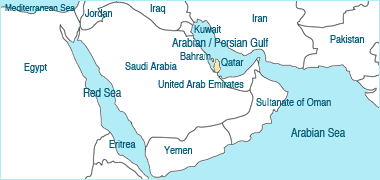
Qatar is a small peninsula projecting from the much larger Arabian peninsula, mostly comprised of Saudi Arabia. The Qatar peninsula was settled from two areas of the region. badu moved into the country with their animals from the hinterland while, from the surrounding areas and Persia, fishers and pearlers settled mainly on the littoral strip. It is debatable which of these groups can claim to have settled first although it is likely that it is the presence of the badu which precipitated the need for trade and consequent settlement on the coast.
Qatar is a relatively small peninsula and, because of this, its settlement was effected differently from the settlements further south along the coast such as Abu Dhabi and Dubai which were more heavily developed. Some believe its character can be thought to compare with the nearby islands of Bahrein, but that also is wrong as there is a long history of settlement there going back thousands of years to the prehistoric settlements known as Dilmun. While there is some evidence of ancient settlement and older rock carvings in Qatar, its settlement appears to be relatively modern. What is certain is that this area of the Gulf was inhabited by pirates raiding settlements and the trade routes to Persia and the Indian sub-continent, and this was one of the determinants in settlement development.
I will talk about the climate of Qatar elsewhere, but it is important to understand that Qatar certainly has a hot climate and, more particularly, that it is is a hot maritime climate. The way in which this determines architectural responses will be dealt with elsewhere.
The population of Qatar
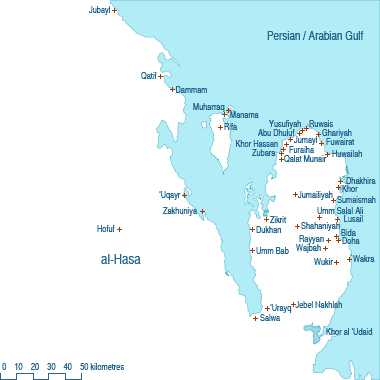
Archaeological investigations within the peninsula have demonstrated that the settlement of Qatar can be traced back six thousand years or more. It is likely that the federation of Dilmun, centred on Bahrain, included Qatar three thousand years ago. Herodotus referred to the sea-going Canaanites as being inhabitants of Qatar in the fifth century BC, and Ptolemy noted ‘gatara’ on his first century AD maps, a reference, it is believed, to al-Zubara which had established itself by that time as a significant trading post within the Gulf.
More settlement within the peninsula took place gradually over a period of time, but three significant waves can be definitely established. The first was a Wahhabi expansion by tribes from al-Hasa towards the end of the eighteenth century. Following this was the movement of tribes from the littoral ranging from Kuwait in the north and along the al-Hasa province of Saudi Arabia in the mid-eighteenth century; and the third was the movement by sea from other areas of the Persian/Arabian Gulf, notably from what is now Iran.
The Ottoman empire governed the area for centuries, including the period when the al Thani family became absolute rulers of the country in the late nineteenth century. This rule continued after the country became a British protectorate in 1916, and maintained as Qatar became an independent country with the British leaving the Gulf in 1971.
The population of Qatar has increased dramatically. This is dealt with elsewhere, though not in great detail. What is worth mentioning here is that in the early 1900s Qatar was estimated to have a population of about 27,000 of whom 20,000 were nationals. Although there was an increase in the intervening years, particularly from the other side of the Gulf, regional instability and economic hardship saw the population drop through the thirties and forties to about 16,000 by 1949.
In 1970 a census counted a population of 111,000 of whom 45,000 were nationals. The 1986 census showed a population of 369,000 and a 1990 estimate raised this to 371,000 of whom 70,000 were nationals. The Planning Council stated that the 1997 census enumerated a population of 522,000 and the 2004 census showed an increase to 743,000 giving an annual increase of 6% from 1997 to 2004, ascribed to the strong economic growth. I will be writing more about this in one of the addenda but it is worth noting that Qataris commonly believe, in 2008, that the population is one and a half million.
Badu migration

Some badu would stay in the Qatar peninsula throughout the year, though they moved around only a relatively small area towards the centre and top of the peninsula. Most of the badu normally spent their summers in the Arabian hinterland where they had not only access to the water of the oases at which they camped, but where they were able to trade wool and milk for the materials they needed – weaponry for hunting or war, trade goods and foods such as dates and grain. For the winter months, which comprised about two-thirds of the year, they moved into the Qatar peninsula and enjoyed the vegetation and bi’r – wells, particularly those in the north of the country. Evidence is that they first settled with their tents and that these might have developed through simple ’arish structures to crude, stone and juss structures which developed with time. More will be written about the diferent groups on the population page.
The importance of wells to the badu should not be underestimated. They were a resource for both the badu as well as their animals and made their ability to live in the peninsula possible. The areas in which the different tribes or families lived was governed by the location of suitable pasture and wells, and it was around these two elements that travel and settlement were established within this part of the Arabian peninsula.
Wells

I have included the photo to the side, taken a little way south of Doha in the early nineteen-seventies, as I believe it is interesting for two reasons. Firstly, it demonstrates the normal form a traditional well takes in the desert. There is a surrounding channel around the well to contain spillage and direct the raised water, and an extension leading to a contained area – out of picture, but similar in character to what can be seen – where the animals were able to drink.
Secondly, in the background it is possible to see some relatively temporary structures. One of these was designed to take a pitched ’arish roof as can be seen from its gable wall. I have only seen a couple of them in the country and was told by one of the sons of the family who used to live here that it was roofed each year with palm fronds.

While the bi’r above was small and circular with the drinking trough rectangular, this photograph is of a much larger desert well with a smaller circular collection trough for the animals suggesting there are less of them to water. You can see that the bi’r had been repaired and lined with a cement mortar and, in the only case of its sort I have seen, there is a galvanised iron overflow pipe fitted suggesting that this particular well may occasionally fill to the top.

This photograph of a third bi’r was also taken in the early nineteen-seventies and again shows the importance of these permanent sources of water in the settlement of the peninsula. The walls of the well were originally constructed with hasa and juss but had been more recently strengthened with a cement mortar protecting at least the top of the structure. The plants in the drinking trough suggests that it may have been out of use when the photograph was taken, a fact that might have something to do with the small settlement behind it being abandoned.

This photograph was taken more recently and is a good example of a small desert bi’r, but one that has not had developed around it the usual protective wall and troughs seen in the photographs above to contain water for the animals of the badu to drink. Two old pieces of timber have been left on top of the opening to assist in drawing water, and the upper metre or so of the bi’r have had desert stones inserted to strengthen the top of the shaft. What is notable is the narrow shaft. I have seen much larger shafts which will have been easier to excavate and don’t know why some are so narrow unless it has to do with evaporation. There are a number of these alabaar in the desert, constructed by the badu and supporting the movement of their animals in and out of the peninsula. These wells are often brackish and not suited to human consumption, the salinity increasing with proximity to the sea as well as by the over-abstraction of sweet water by the increasingly expanding gardens associated with the rawdtha deposits.
Although there is some evidence of prehistoric remains in Qatar with a variety of stone shelters implying a form of permanent or semi-permanent settlement, the first modern homes within Qatar are most likely to have been the tents of the Badu, later supplemented by permanent shelters constructed of materials sourced close at hand. The tent provides five things for the Badu: mobility, shelter from the strong sun, protection from the driven dust and sand, cover against the cold and rain, and privacy. In all this it is a brilliant example of a successful design.

While this is not a bi’r as such, the photograph is included as it has a historical importance as well as a relationship with the alabaar that dot the country. This used to be the largest body of standing water in the peninsula, though it dried up in the summer months. The photograph looks south-east over the khazaan at Umm Salal Muhammad, and was taken in February 1976. The water is contained by a dam to its north and collected every year. I have another photograph of it taken in March 1975 showing it nearly empty, and one in May 1979 also showing it full. However, I was told that a borehole had been made in it with the object of obtaining a permanent body of water, but having the effect of emptying it permanently. I am not able to vouch for this but what is evident is that the extensive plantation to its north had died off.
Badu tent


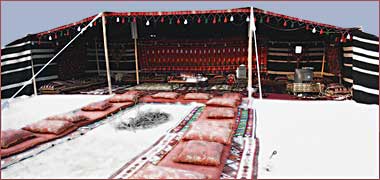
Tents in a variety of designs have sheltered migrant peoples for thousands of years. These first three photographs illustrate some traditional badu tents, photographed in Qatar, the first looking at the back of a traditional tent, the photograph taken from an early Ministry of Information publication. Note the characteristic striped pattern of the material used to form its walls, a function of the manner in which the material is woven. The second photo illustrates a tent in use at one of the annual commemorations of National Day, the third was taken more recently and is essentially the same as the first – except for the television in the right hand corner. It has evidently been laid out for entertaining guests.
Please bear in mind while you read these notes on tents that they refer mainly to tents used in Qatar and that, in many respects, there have been changes over time. The diagrams set out below are essentially theoretical, many of the badu tents using different forms and materials as they come to hand. For instance telephone cable and detonating cable have been recorded as being used for guy ropes, and plan forms are often adapted to daily needs. But, more important, society has moved on. Urbanisation has been encouraged, nationality issues have affected many badu and greater wealth has had an impact on both work prospects as well as recreation related to living in the desert.
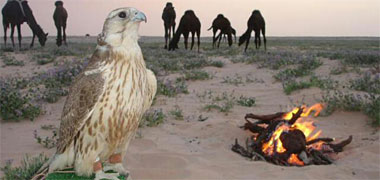
The tradition of the desert and its living patterns still runs deep in Qatari culture, particularly with those of badu descent. This image in many ways epitomises the feeling for dusk in the desert; the comfort to be found sitting with friends around a fire with the camels safely tethered and the hawk alert to the conditions of the natural environment around it. The accompanying tent with its shelter, but open aspect, enables this character of lifestyle to continue.
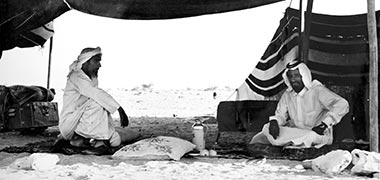
There is considerable comfort to be found in life in and around a tent, part of it perversely based on feelings of comfort and permanence in a mobile life. This old photograph illustrates something of this simple way of passing the day; two badu sit and talk. Between them is a Chinese thermos flask containing the Arabic qahwa, characteristically flavoured with cardamon.
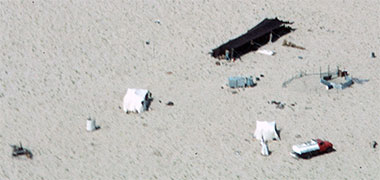
Here is part of a view of an encampment in the desert. There were, in fact, two traditional tents, this one being shown as exemplifying the elements of a camp, the other being situated around sixty metres away, out of the top of the photograph. The main tent has been erected with its back to the shamal. Drectly in front of it is the area for making coffee and, around twenty metres in front is a pen for their animals. There are water tanks near to the tent and two canvas tents for storage. There appears to be a small water bowser in the bottom right corner of the photograph.
Even in sedentary cultures it is known that permanent buildings may be abandoned for part of the year when their occupants will revert to their more moveable homes either for harvesting crops or, more recently, even for pleasure – perhaps a reinforcement of the psychological need to enjoy a simpler lifestyle. The advantages are obvious. Tents can be moved to any part of a country where there is something of value to the migrants. They can be struck when that commodity is no longer there in sufficient quantities – whether it is weather or fodder – and moved on to another location. In doing so the migrant benefits the land. The droppings from their grazing animals fertilize the soil and help to maintain the marginal soils of the arid areas in which many of the migrants live. Perhaps one of their greatest benefits is their impermanence: not only the length of time they stay in one place, but also the materials from which they are made deteriorate with time and must be replaced. They have little adverse effect upon the country in which they stand, and they leave little behind them.

In addition to the environmental advantages offered by tents, there is also the beauty of the material and construction that is not as apparent in the more permanent buildings that developed with time. In other words the designs of tents are less likely to be dependent on style and fashion, and more correctly reflect the honesty of their construction. This photograph shows an accurate view of a typical tent, however it is a more romantic view of the traditional life of the badu with their horses and camels standing at the mouth of the tent while the men of the family and their guests sit at rest.
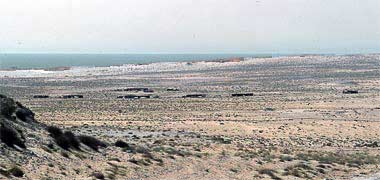
In real life the tents of the badu differ slightly in size and design. Encampments of the badu move with time and can be seen in various locations in the desert as their owners move into and out of the peninsula. This first photograph was taken on the west side of the peninsula in the early nineteen-seventies and shows a group of badu tents spaced out with their backs to the north and the sea beside them. There is sufficient grazing around and the families would have remained there until the grazing gave out.

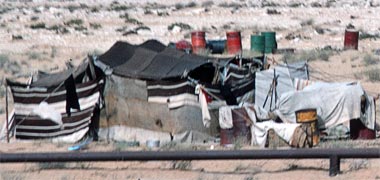
Here a family of badu have erected a pair of tents next to a pipeline, which has the distinct advantage of containing their animals from part of the desert. These tents are typical of a working badu encampment. Note that oil drums have been used to anchor the tent guy ropes, probably because they provide more sound fixing points than with pegs in the sand at this preferred pitch for their camp.
The second photograph, a detail of that above, gives a little more indication of the way of life in the camp. It is a less romantic, more realistic view of how the tent and its immediate surroundings are normally used. Washed clothes drape ropes, and a secondary enclosure has been arranged with a tripod from which to hang a cooking pot. Note that the area around the tents is relatively tidy and free of rubbish.
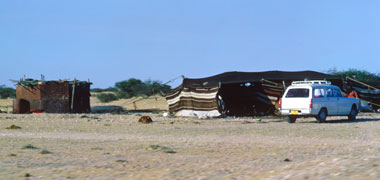
Here is a second encampment of badu in the centre of the peninsula. This appears to be a relatively long term camp as, to the left, a kitchen block has been fabricated of beaten out oil drums. It appears to have a roof to provide protection from the winter rains. A taxi stands on the right suggesting that somebody has been brought to the camp or, as I believe more likely, that the driver is a badawi, an occupation begun in the nineteen thirties with the discovery of oil. It illustrates something of the process under which rural communities begin the process of settling into a more urban way of life.

These next two photographs illustrate contrasting conditions of badu camp within the peninsula due to the seasons. The first photograph is of a good-sized tent set up in similar conditions to that in the photograph above. There is fairly heavy sand and low scrub in the area around the tent. A pickup truck with high sides for containing animals is parked at the front of the tent, and children are playing freely around the tent.

Contrasting with this, here is a smaller tent that has been established in higher scrub such that it was almost hidden from sight. Although there is more animal grazing on this type of ground than in that above, the camp appears to be less permanent, certainly not one associated with other tents, perhaps suggesting a temporary base as livestock are moved around.
![The modern tent, with permission from [Qatari] ? The modern tent](./islamimages/newtent.jpg)
Nowadays tents are used by the tourism industry and by many families, particularly in the winter months. Rarely are traditional tents used by anybody other than families that can still afford to keep and maintain them so it is usually the canvas variety, the bayt khiaas, that spring up in the desert in season. They are not always as large as traditional tents but their roofs tend to be higher. In this photo you can see that the arrangement is exactly the same as with traditional tents, with projecting walls and a low shelter protecting the cooking area.
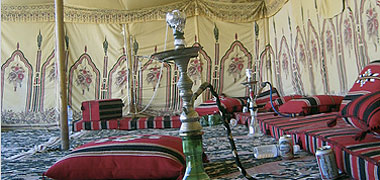
As mentioned above, nowadays tents are made of canvas, the more expensive having decorated panels lining their interiors. Few of the internal linings seem to be traditional, many of them being the bright colours and patterns from Egypt, particularly the appliqué type – though not in this case. Seating is still traditional, as you can see in the lower photograph with a row of dowshek and masaanid to lean on, and with good quality carpets laid directly on the ground.

The badu tent can still be seen in its traditional rôle in the desert. But increasingly they are used both on recreational or festive occasions as well as having a useful function as a majlis, particularly for those with aspirations to or connections with the main badu families in the peninsula. While I have no recollection of where this photograph was taken, it represents such a use, set in a Qatari garden, most probably for a wedding reception.
When reviewing the manner in which Qataris live nowadays it can be instructive to analyse the manner in which tents were constructed and life lived in and around them, and to contrast this with the way in which housing than developed in Qatar.
Tent construction

Women make tents. Men may fashion the wooden elements of the tent, but it is the women who shear the goats, spin the yarn, weave the tent fabric, and assemble and decorate the tents. As a reflection of this the women’s area of the tent is often larger than the men’s as it must accommodate not only the looms, churns and utensils, but also the activities of the women as well as men when they’re entertaining or relaxing in their side of the tent. The men’s area, by contrast, contains the weapons, harnesses and saddles and is the area where guests are entertained and spend the night. These practical roles of the badu are similar to those required by the Holy Quran with the women being given the central and focal role of looking after the home and the education of the children. In this they have an extremely powerful role that has continued to this day. I shall write about the way this is now changing elsewhere.
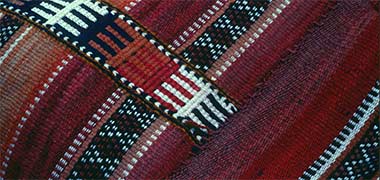
The different parts of the tent, both the main materials that are designed to protect against the elements as well as those designed for decoration and privacy within it, are constructed in a simple manner. This is very much a case of necessity. Their unsettled life means that there is little that can be constructed and used that can not be taken down and moved as the badu migrate with the seasons. Among other things, this means that weaving frames have to be simple and small. In effect this has brought about the custom of weaving the material from which tents are made on a simple frame pegged out on the ground and in no more than half a metre wide strips. The greatest evidence of this is in the internal hanging wall or lining runners.
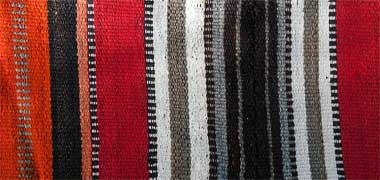

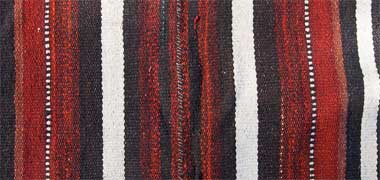
This material is woven from wool dyed in strong colours. In the tents I have seen in Qatar the patterns tend to be straight, lineal bands established as rows of different widths running along parallel with the ground. The details of tent wall materials shown here are all displayed at right angles to the way in which they would be seen within a tent. The reds and oranges seem to be very common in their use with orange a particular favourite, though in the three examples shown here, the main colours are black, brown, red, white and grey.
Variation to the runners is brought about mainly in three different ways. The first is in the choice of colours and their combination on a particular piece. The second variation which can be made is through the relative widths of each of the bands, though rarely is a band more than ten centimetres wide. The next variation that can be made is in the junction of the bands. These can be clean junctions or combed with the two adjacent colours toothed into each other usually by no more than half a dozen stitches as can be seen in these examples. Finally, though perhaps not a deliberate decision, many of the colour bands show considerable variation in their colouring, particularly in the more natural colours of the black-brown range.
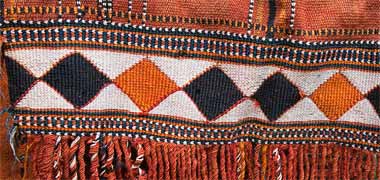

The ends of the runners do not always have a special design at their ending and, within a tent you would not expect to see a single piece running all the way round it; two or more runners would be hung with their ends touching or overlapping. The reason for this is that the tent can take different sizes and there has to be a degree of flexibility in the sizing of the elements from which it is constructed. Where a tent has a formal status it might be anticipated that the walls will be woven to specific lengths to suit its arrangement. This first example shows a typical ending for such a piece of weaving, but this can vary in many ways. The last of this group of photographs is a detail of the piece above it and shows the simple manner of creating a running triangular pattern to enliven the piece.
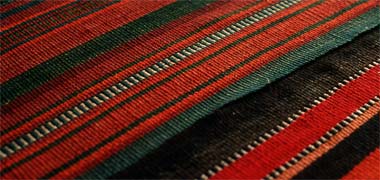
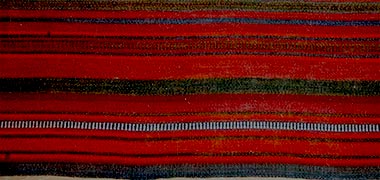

These three photographs are of two other runners from Qatar. They are very similar in their pattern and colouring and are, therefore, likely to have been woven by the same person. The first photograph is an oblique detail of one of the runners intending to show something of its character. The second photograph shows one half of the second runner, the other side being a mirror image of the side shown, and with the centre of the runner being along the top of the photograph. It is evident that the two runners are very similar in their colour and patterning.
The runners are made up of two woven pieces, each around 430mm wide, but the lower runner is more interesting in that it has been finished with a simple band across the two ends of the joined weavings, and the ends of the warp threads plaited and knotted into a tasselled finish as is illustrated in the third photograph. My understanding has been that these runners are used as tent walls but I have also seen them used as floor covering in relatively small areas, larger areas being covered with kilim that will have been readily available in the area from their manufacture in Iraq and Iran. Unfortunately, I am not able to say where these runners may have originated.
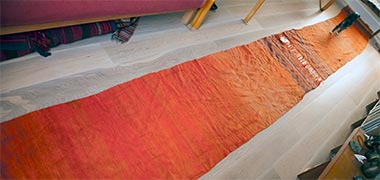
Regrettably this fact is also true for this next piece which is different in many ways from those above and will not have been woven in the same manner. The piece is comprised of two runners. Its width is approximately 76 centimetres and its total length around seven metres. Its colour is a distinctive orange and the wool was not dyed to a consistent colour as can be seen in this photograph.

Its most distinctive character is that it was woven in the manner used on many carpets – with the warp threads going over a horizontal bar on the top of a loom, and two pieces being woven, one on each side. The lower photograph illustrates the centre of the whole runner showing the breaking in the weft threads, the warp threads running straight through. The piece looks completely different from the traditional badu pieces, but it was bought in the old suq in Doha and would have been used most probably on a wall or floor. It is surprising that it had not been cut into two pieces as was the usual practice. It is unusual to come across woven carpets in this form.
Weaving

This first illustration, taken from one of the Qatar government’s web sites, shows the relatively sophisticated portable weaving mechanism, which I believe is located in one of its museums or touristic displays in Doha. It should be relatively easy to imagine how this mechanism would look pegged out in the desert without, in this case, the supporting wooden base arrangement needed for the display, and without the carpet.
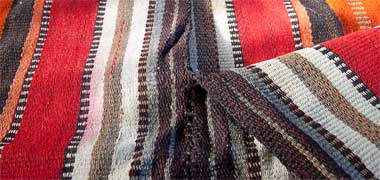
It is evident that the scale of equipment has much to do with the need for mobility, but the resulting material is, as you can see from the photograph, relatively narrow. But it is from this width that most of the woven items needed by the badu are constructed. In this photograph it is possible to see that two widths of woven material have been butted together and joined with a form of catchstitch which has the advantage of being a fast way to join two pieces as well as enabling them to be taken apart readily should the need arise.
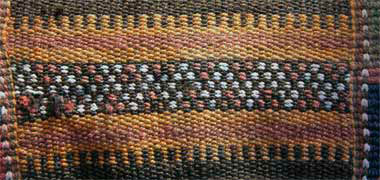
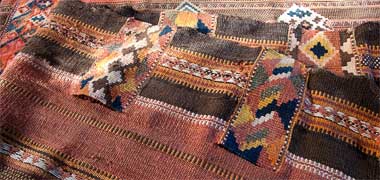
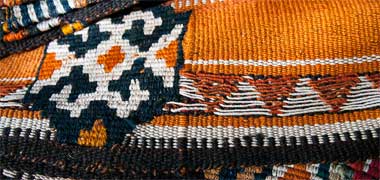
This method of weaving produces distinct patterns, of necessity in a stepped manner. These kinds of patterns can be seen all over the world where simplistic weaving has developed. The main differences are the materials themselves, the colours available to the weavers and the scale created both by the size of the threads used as well as the way in which the threads are grouped in pattern making. A slight difference can be seen in Iran where kilims have developed with returns of the weft threads creating slits, parallel with the warp, in the finished piece. This does not generally occur in the Arabian versions. These first two examples, albeit, not too clean, illustrate typical materials used to form the decorated walls of tents. The benefit of this type of weaving is that the material can be used on either of its faces. The third photograph, however, shows the reverse of a piece of tent material and shows how threads are carried across the back of the material in order not to show on the face. Another example is shown two photographs lower down the page. You can also see two vertical slits each side of the four-sided pattern where the threads have been reversed, this slit bearing a similarity to Iranian kilims, though this example being much wider than those woven into the kilims.

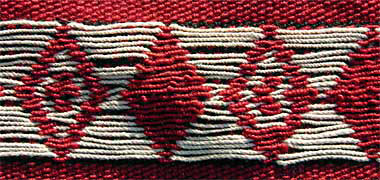
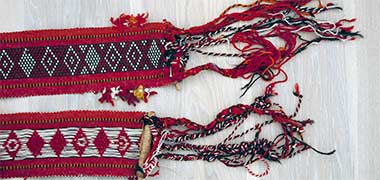
Sometimes, however, material is woven so that it only has one presentation face – as in this top photograph – and the back of the material – as shown in the lower photograph – hiding its construction as in this example which is used as a part of the harnessing of a camel. These narrow strips of brightly coloured material are a common feature of the trappings of camels. Tassels are usually created to the ends of these strips of material, adding colour and movement as they sway to the motion of the camels’ walk. It is evident that decoration of this sort fulfills a number of different functions for the badu illustrating, at least, pride in their animals combined with a desire to decorate and enhance their immediate surroundings within the very limited facilities available to them.
The woven piece illustrated above has been finished with the warp threads braided into tassels at both ends. Each end has also been carefully fitted with a piece of timber sewn to the outer edges of the piece. Its purpose is both to keep the piece flat when in use and under tension as well as enabling a fixing to be made to it when and if necessary.

The functional purpose of the weaving, I should have mentioned earlier, is related to the need to have containers for the many different items that are used in their day-to-day activities, particularly when the badu have to move. Storage bags, rugs and tent walls are the main items woven, along with dressings for their camels. For those interested in badu weaving, considerably more information can be found here.

Here is another example of a decorative piece of weaving, created with little practical use, but capable of being added to a number of trappings in order to create a visual display. It is 60mm wide. The strands of wool, both weft and warp are thick and the weaving dense, creating a strong piece but, as can be seen, there appears to be no functional use for it other than as ornamental decoration. The pattern is simple and the colours strong suggesting that it has not been used.

It is an odd piece of weaving. There are fifteen warp threads which have been stopped at the ends and then bound or whipped into three elements, each of them apparently two groupings thick – suggesting that five warp threads have been brought down to two equal elements. The ends of each of the five warp threads have been whipped and the loose ends allowed to create tassels.
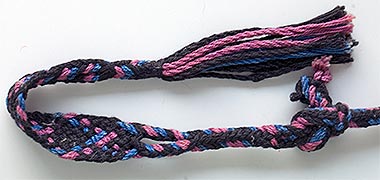
Not only did the badu weave pieces for storage and decoration, but they also produced simple braided pieces for tying items together, and these would often have a decorative treatment. Here is a small piece of braiding, a little over a centimetre wide, which has been flat braided then split into two cords before being trained into a single cord. The end, at the top of the photograph, has been whipped and the threads left to form a tassel. At the other end, the piece has been simply knotted to another, similar, piece, the total length of the cord being around a metre long. There is a sense of enjoyment in the manufacture of the piece as there is no rationale to the piece unless the split in the cord was designed to receive a toggle or other fixing device.
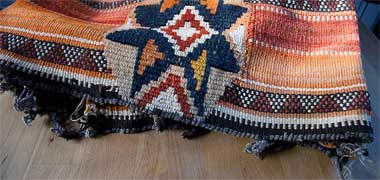
This photograph shows the edge of a woven tent wall lining. It is her not only for the range of colours that can be seen in this particular piece, but also the loops woven into its edge in order to suspend the wall on the lines strung inside the tent. These are substantial pieces of material and considerable bulk and weight to them. Not only do they create an attractive lining to the walls, they contribute to the environmental effects regulating the temperature and humidity within the tents.

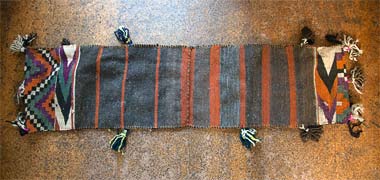
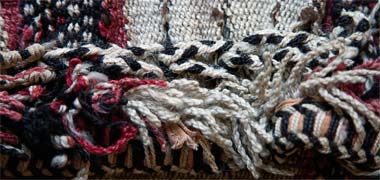

Earlier I mentioned how weaving was the standard method of creating many of the items needed by the badu in their day-to-day activities both within their encampments as well as when on the move. The first two illustrations here are of the front and back respectively of what are generally called camel bags. These items of daily use are created from a length of woven material, turned over at the ends, sewn closed to form pockets at each end and decorated with tassels and loops required to close the bags. They are designed to be thrown over the back of donkey or camel and contain small daily items. The loops across the centre are used for securing the bags. They vary significantly in their design. Even the utilitarian bags tend to be relatively decorative and, with their colourful tassels are increasingly being made in order to satisfy a growing tourist market. For this reason there are a wide variety of designs to be found. This bag is from the 1970s.
The third photograph here is a detail from another similar bag illustrating the common method of securing the bags. This is effected by interlocking a series of loops which have been woven with interweaving black and white woollen thread, here seen crossing the photograph horizontally. In this manner the artefact relies solely on the wool for its construction. The last photograph here shows the other end of the bag at a different scale. The row of fastening loops can be seen close to the bottom of the photograph. Also illustrated is the different character of pattern making as well as the construction of the tassels, here braided compared with the tassels shown above.
Tent material
The tent is known among the badu as the bayt sha’r or house of hair. Preferably it is constructed of goat hair which gives its distinctive dark brown-black colouring and which has the physical properties required by the badu.
Goat hair is very strong in tension and the strands relatively long. Occasionally sheep wool or camel hair is added for effect, but the former elongates under tension and the latter is too short to form effective yarn. The yarn for tents is spun from the goat hair using a mighzal or drop spindle and then woven on a sadu or a simple loom pegged out horizontally into the desert. The material which is woven from it is normally approximately sixty centimetres wide and the resulting strips, filli, are then sewn together with a goat hair thread to make the tent and its walls as well as a number of other necessary bags and mats – the tenting material having a denser weave in order to help shed rain. The width is a traditional measurement based on the distance between the tip of an extended finger to the elbow.
The material used to form the tent has to be hard wearing under the tough conditions in which the tents are used. The material lasts about five or six years. As and when they wear out the strips comprising the tent are mended or replaced and, eventually, perhaps cycled to the bottom of the ruaq or discarded completely.
Environmental response
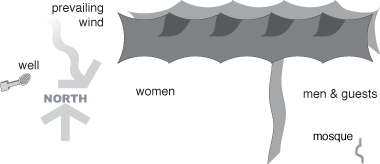
Note that, in these illustrations, the women’s section of the tent is larger than the men’s as that is the family’s living area in which the tasks of the family are carried out, and the men and women of the family use daily. The men’s area is essentially for relaxation by the men of the family and, of course, for entertainment of guests. Note the arrangement of stones to the south-east of the tent that serves to act as a mosque.
As a solution to the problem of shelter the bayt sha’r is almost ideal. In rain the yarns swell slightly which helps to block the ingress of water through the weave, and the oily character of the goats’ hair assists in shedding water. Prolonged rain will eventually come through the fabric and it is not uncommon to feel a very fine mist coming through the tent prior to this. I don’t know what happens to it under really prolonged rain but have heard that the atnab, guy ropes are adjusted to minimise standing water on top of the relatively flat profile. Nor do I know if using hands or poles to move the tent structure upwards and shed water will encourage water to move through the material at contact points as I recall from canvas tents. Perhaps somebody will tell me…
However the badawi does not have the concern for this that others might have. Firstly, rain is welcomed for the benefit it brings to the pasturage, secondly, because he knows percolation to be a characteristic of the tent and, thirdly, there are not many things in a badu tent which would be damaged by slight water ingress. Rather he is aware of its characteristics, and grateful for the tent giving him a degree of protection which he will not have outside the shelter.
Additionally, its relatively light weight is a benefit to him, as is its slightly transparent feeling. Sitting under the shade of a bayt sha’r you can see light coming through the small holes in it and are very much aware of its light character. Reinforcing this character, air movement or winds will move the fabric slightly which helps air to circulate around the interior of the tent as well as aiding psychologically with the feeling of coolness.
By contrast, within modern houses the badu tends to experience a real psychological concern about the apparently unrelieved mass above him, which is reinforced if the ceiling is relatively low. There appears to be a distinct difference in the feeling for the oppression of a solid ceiling compared with that of the material of a tent even though this is generally lower than the ceiling of a house; perhaps caused by the knowledge of the lightness of the tent structure, the fact that it is only half covering the space, and the slight movement of the natural materials.
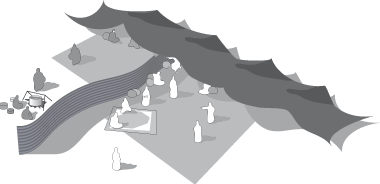
In addition to letting in some moisture, the tent also admits the wind and breezes. In the hot months of the year this is a positive benefit as any cooling breeze is welcomed in order to help reduce further the temperature within the tent, or to increase the effect of cooling, either psychologically or by transpiration. Having said that, the temperatures within a tent are considerably lower in summer than the temperatures outside. The bayt sha’r absorbs heat because of its colour, but it also dissipates that heat quickly due to the loose weave of the material. The colour of the tent also provides much darker shade than would a light coloured material, and it is impressive to compare the coolness of a bayt sha’r with that of a canvas tent – even if the latter is lined. I should also mention that it is common to have the ruaq – the walls of the tent – taken down completely in summer, using just the roof elements to provide shade, and the tent form itself assisting in drawing air through the interior utilising the venturi effect.
But there is another environmental effect that should be noted within a tent. There is a gradation of heat over the cross-section of the tent. Immediately in the front of the tent – which will have been pitched facing more or less south – the ground will be very hot. Inside the front of the tent the shade will have lowered the temperature of the ground and, at the rear of the tent, and due to the slope of the rear of the tent away from the sun’s rays, the ground will be even cooler, this graduation of temperatures causing convection currents which are noticeable. Generally, the temperature inside a tent under sun is 10-15°C less than outside.
Having said that I should add that the al Na’imi kabila, who live permanently in the north-west of the peninsula, used to have stone houses into which they moved in the hottest part of summer. It seems to me that this must be due to the diurnal thermal lag of the stone structure providing relative coolness throughout most of the day, discomfort becoming an issue in the late afternoon. I would also assume that the stone house would only be better than a tent when there is no air movement – but I have to admit that I have not had this confirmed by anybody with the relevant experience. It is recorded that people slept on the roofs of these structures.
In winter the wind can be more of a problem and, to some extent, this is dealt with by siting the tent carefully in a declivity of the desert – although not in a wadi where the tent would be at risk from flood water – and by using stones or brushwood to reduce the impact of wind on the sides of the tent. The ruaq tent material does not touch the floor as, in that situation, it would be liable to rot. The lowest elements of the ruaq are normally constructed out of a material which can be replaced – sometimes canvas, sacking or a piece of tent that has outlived its position within the body of the tent – and can be held down with rocks to assure a more wind-tight enclosure.
Tent structure
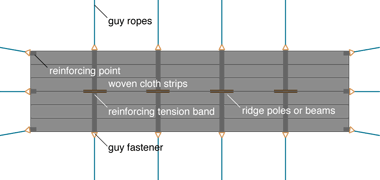

The bayt sha’r of the badu is a sophisticated structure that has developed over centuries into the deceptively simple housing it has become for those who live in and around the Arabian peninsula. Rectangular in plan and guyed by long ropes, lakh, it has a relatively flat, low, aerodynamic profile created by its tensile guy ropes and wooden props which helps to counter and reduce the effects of any strong winds that may sweep over it.
Although these structures are usually considered to be a single style, there are a number of different forms taken by bayt sha’r over not just the Arab world, but farther afield where the availability of similar materials make this type of structure a natural choice for the provision of, generally, those who need or choose to be mobile.
However, the structures in Qatar seem to be similar conceptually, the only difference between the northern and southern badu tents appears to be that the latter are lower and have shorter maqataab, ridge poles or beams and which are doubled compared with the longer, single northern arrangement. The maqataab are used to spread the area over which the roof fabric has contact.
The tent fabric is held up with ’amuwd, wooden poles tallest in the centre of the tent, lower at the back than at the front. A wooden device at the top of the central internal vertical poles serves to spread the load over the fabric which itself is reinforced with qatuba, tension bands.
The ’amuwd come in three different lengths and have different local names: mazdm, waasut and mikhir, respectively named for those at the rear, centre and front of the tent.
For more information about tents consult Ferdinand’s and Faegre’s books which were the main sources for research on issues relating to Qatari tents, particularly the former.
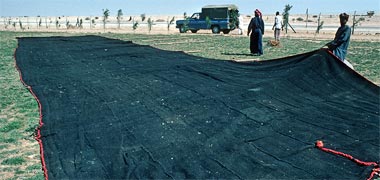
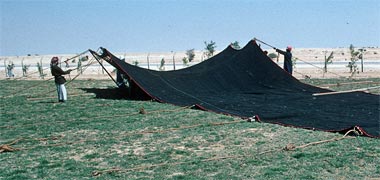
These two photographs show something of the character and size of a badu tent. As you can see, this tent was not being raised in the desert, but for an event planned where it was intended to invite and entertain dignitaries in a traditional manner.
While it is not possible to see the reinforcing tension strips sewn to its underside, the panels making up the tent roof and the surrounding red rope sewn to the tent material to strengthen it at the edge can be clearly seen. In the lower photograph, the guy ropes have been attached on all sides, and the lifting of the tent has begun at one end. It is noticeable that the erection is being carried out only by two men. In the desert this work is often carried out by both men and women and, where speed or wind conditions require it, far more people will be involved in the process. The photograph below shows a similar tent erected for a similar reason.
Tent walls
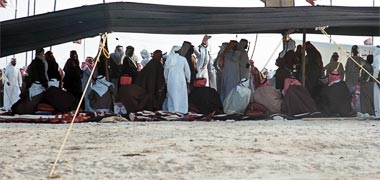
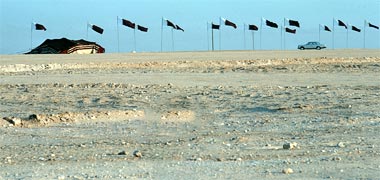
As can be seen in the photographs and illustrations above, the tent is a simple enough structure. In use, however, its apparent simplicity belies its ability to cater for different conditions. It can be readily adjusted to take account of weather conditions – notably wind and humidity – but also for social conditions relating to privacy. In this photograph, taken in the early nineteen seventies, a tent has been erected in the desert in order to enable dignitaries to be received under shade. It is being used, in effect, as a majlis where the tent wall has been dropped completely in order to maximise the cooling effects of through breezes as well as permit all to see what is happening within it. The lower photograph shows the same tent with its walls up, sitting on a low hill in the desert and surrounded by national flags, prior to the dignitaries and guests arriving later that day.
The walls of tents can be thought of as of two types, the qata or central, dividing wall or walls and the ruaq, or external walls.
The qata is usually highly decorated and extends into the desert in front of the tent. In fact, on a large tent there may be more than a single qata. Its purpose is to divide the family activities from those of the men, particularly when there are guests on the men’s side. In this its function is to provide privacy, and it is usually highly decorated.
The ruaq comprise the majority of the tent walls, enclosing the tent on three of its four sides. They are constructed on the same lines as the roof of the tent but in a looser weave and, usually, striped red, natural beige and black. Nowadays the tent might have an additional internal wall to provide decoration and extra insulation.
The junction of roof and wall is effected relatively simply. Large wooden pins, khilaal, are used to attach one to the other at approximately one metre intervals. In some circumstances the khilaal have rings at the end with a running line through them in order to keep them together and prevent their being lost in the sand.
The junction of ground and wall is a bit more complicated. As I wrote earlier, the foot of the ruaq is usually sealed by being weighted down with a row of stones, but can be buried in the sand in order to provide a seal against the elements. This would be a relatively normal arrangement for that part of the year when the ruaq are used for privacy and protection. In summer, the ruaq might be taken down completely. Obviously burying the edge of the ruaq can damage it, so the bottom of the ruaq usually has added to it a piece of sacking, canvas or an old piece of tent or ruaq material to which further damage is not important.
When the weather cools the bayt sha’r can be a little cold. To keep it warm the qata can be turned back to seal the open side of the tent, the internal fire keeping the tent warm through the night.
The winter months were particularly dangerous with regard to water and, in order to deal with water run-off a small ditch would be dug with a raised barrier, about twenty centimetres high, on the tent side and with stones on the other side of the channel to weigh down the bottom of the ruaq. The channels were essential to collect water and lead it away from the tent.
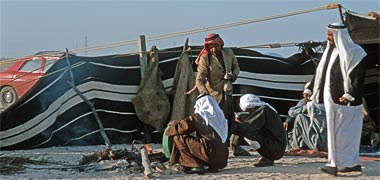
This photograph illustrates the end wall of a tent, used in a similar way to a qata though, in this case, not for dividing the two halves of a tent for men and family, but to provide shelter from the wind for a tent set up as a majlis for men and their guests. Part of the qata is suspended from a guy rope, but it mainly obtains its support by means of a branch of wood to give it the necessary height, shielding the activities of those around the small fire.
Guy ropes
The guy ropes, or lakh, are relatively long, to a large extent this being necessary due to the way in which fixing into the ground is effected; soft soils don’t allow tent pegs to take their loads vertically but require shallow lateral loading to prevent the pegs being pulled out. But the long guy ropes have another function. Their length, and the fact that they are made of hemp, creates elasticity and this acts to damp the forces made on them by any fluctuations of the wind.
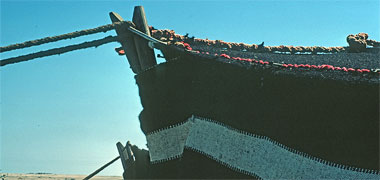
Their connection with the props holding up the tent are made with one or two methods, the first method illustrated here. The top photograph shows how the end or side guy ropes are fixed by means of a simple loop over the top of the tent pole which has a forked device at its head constructed by fixing a smaller piece of wood to its head. Guys, as well as – in this case – the roped edge of an extending side wall, are simply looped over the top of the pole.
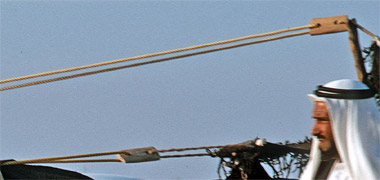
The guy rope usually is connected to a flat wooden panel, approximately 300mm x 150mm, that has two holes in it, one to take the shorter loop that is fixed to the tent, and a much longer loop that is attached to the pegs that hold the tent to the ground. The first photograph to the right shows the manner in which the top of the tent pole is fashioned, and how the rope loops over the top of it, and the lower photograph illustrates two of the wooden panels. The use of these devices allows shorter lengths of guy rope, but also has some degree of friction associated with them, permitting the rapid tightening and loosening of the guys depending on weather conditions.

The second method of attaching the guy ropes to the roof is shown here with the fixing of the guys to the long side of the tent roof. The reinforcing tension bands sewn across the tent roof are around 300mm wide and, at their open ends are doubled back to form a sewn, fixed loop. Through this loop a short piece of wood is threaded to the ends of which two strands of a fixed length guy rope are attached. This rope, in turn, is threaded through a hole in a wooden panel which, by its second hole, is fixed to a tent peg in the ground with a guy rope.
Tent pegs
Both soft and hard ground conditions can be met at camping sites, so badu must be prepared for either contingency, or even both at a suitable site.
In the past, sometimes small bushes were used as anchor points in soft ground. Buried sixty centimetres or so under the ground, the branches of a bush are able to spread the loading placed on it by the guy ropes. Nowadays, there seem to be three solutions. The traditional one is to use stones or, in sand, bushes, stones or sandbags.
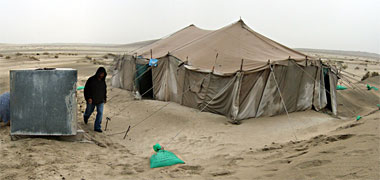

The main problem with using stones to which to anchor guy ropes is to ensure that movement caused by the wind doesn’t fray the ropes through continuous friction. Perhaps due to the large amounts of steel introduced for the construction industry, I have seen steel pegs, misaamir, used, both straight and spiral, the latter having a loop at the top which enables them to be screwed into and out of the ground. Steel pegs tend to be flattened at the top from hammering into the ground but which also creates a mechanical device to counter the possibility of the lakh slipping off.
These two photographs show the use of plastic bags filled with sand to tether a modern, canvas tent – as well as two camels. I’m a little surprised at the use of these sandbags as tying a safe knot at the mouth of the bag is not that easy, and I would have thought that, in a strong wind, the bags would not be as sound as traditional solutions. Notice also that the misaamir which are used in conjunction with the sandbags are hammered in vertically rather than at an angle, which is a little surprising.
Finally, it is also worth noticing that the sand around the tent is used to seal the junction of the bottom of the canvas wall with the ground, and there is a trench around the tent to collect and lead water away from the tent in the event of rain.

It can be seen from the above that a variety of methods are used for holding down tents, and that the methods vary depending on the character of the ground on which the tents are pitched. In order to cater for each circumstance the badu carry what they need. However, sometimes they can be lucky to find what they need on site such as the sand above, or stones. In this photograph you can see that the ground is level and suited to animals’ grazing. You can also see a number of stones lying around, and it is likely that these will be used over and over again as people use the site to pitch their tents here before moving on to another spot.
Arrangement
Although badu tents differ in size – as you might anticipate, in accordance with the wealth of the owner – they usually have a proportion with length two to three times that of their width, and are divided into two distinct areas for the men and the women by a qata – a dividing wall – which goes across the width of the tent and extends some way outside. As I mentioned earlier, the women’s or family side of the tent is always larger than the men’s side. This qata is often highly decorated as it is seen by all visitors, and it also serves to enclose the front of the mens’ or women’s side of the tent when necessary either for privacy or when the weather warrants it.
More accurately, the size of a tent is determined by how many central tent poles they contain. The one I’ve illustrated above would be considered to be a four-pole tent. Most tents are smaller than this but the head of a tribe might own a five-pole tent. What I haven’t mentioned earlier is that the tent covering has to be carried by the pack camels. This usually means that the six widths of material which make it up are broken down into two three-widths to be carried by two camels, the material being sewn together prior to being erected.
In the open desert tents are pitched with their backs to the prevailing wind – in Qatar with their backs to the north-north west, the shamal wind – and the men always occupy the eastern half of the tent, to the right of the tent as it is approached. Although it is difficult to be certain of the reason for this, there is the possibility that it relates to the preference given by right-handed swordsmen to the setting in which they might have to fight and, in this, is similar to the manner in which some fortified buildings are said to be arranged. Incidentally, it is also the side to which the majlis is positioned in permanent buildings. Guests are entertained in the men’s part of the tent where there is always provision for the fire on which coffee is prepared, although the cooking of meals is carried out by the women on their side of the tent, usually outside it.
In the open desert, the tents of a tribe would be dispersed in a relatively formal manner, that of the head of the tribe being at the top, north, end of a u-shaped arrangement in order to mark his prominence and form the focus of the encampment. However, a more dispersed arrangement was usually necessitated by the relatively scarce supply of feeding for the animals and, perhaps access to water. In this case the head of the tribe would take the better area and the other tents would spread out over whatever distance was necessary to provide for each family group.
Tents are also distributed with regard to the closeness of family relationships, close families having their tent guy ropes overlapping.
Visitors
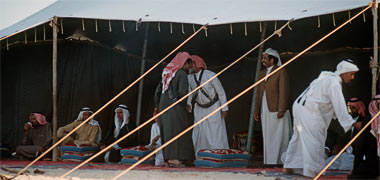
Visitors always approach tents from the front, even if they must make a wide detour in order to do so. This enables them to be seen at a distance, the men warned and the women to move into the privacy of their quarters as well as to begin the procedures for the welcoming of guests. Arab hospitality is legendary. A host is required by custom to entertain anybody who comes to him for three days before he may even ask what he can do and where the guest is going. Customarily he also assists the guest in moving towards his next point of call. A wide range of stories have evolved and which are kept alive by the badu dealing with the concepts and practice of hospitality. Stories of individuals such as Hatim Tai, who slaughtered his favourite horse to feed an unknown guest, are regarded as central to the codes of honour and traditions of which all badu are aware and of which they are extremely proud. This tradition is still alive today, despite the pressures upon the developing nations of the Gulf.

This photograph, and that above, were taken in the early nineteen-seventies at a tent raised to accommodate guests on the occasion of a national celebration. As you can see, it is not a traditional tent but, otherwise, it is functioning in exactly the same way, the main differences being that it is larger than a traditional bayt sha’r, the lining is with a modern material, and it is taller, those occupying it having a greater sense of space than in the traditional tent.
Hospitality

Hospitality is an imperative in the desert, a tradition that has been practised for centuries and one that is held in considerable respect. In the first of these two photographs a guest has brought his camel up to the tent where it stands near the fire – at which musicians are tuning their drums – waiting for its owner to leave. Note the typical badu saddle arrangement. This end of the tent seems to be the one that is used for the preparation of coffee and tea and often has a fire located there.
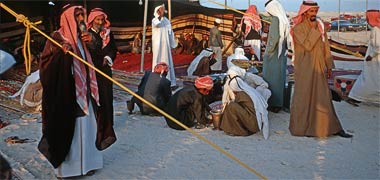
In the second photograph an elderly badawi is seen being escorted as he leaves a traditional tent where he will have spent some time greeting and exchanging news with his friends. Behind him, and contrasting with the previous photograph, a group of men are busy with the necessary work of preparing coffee and tea over an open fire to serve to the guests. Coffee is the first of the drinks given to guests when they arrive, followed by tea.
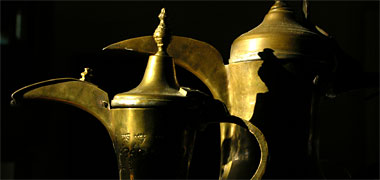
The traditions of the badu are to be found encapsulated within the houses of the modern Qataris. Privacy for the women is still a requirement and houses are divided into the salaamlik and haramlik – public and private areas; the majlis is preferably to be found on the right hand side of the entrance – medkhul – to a house where there is provision for making coffee and for peripheral sitting on dowshek – low mattresses, and propped by the elbow on a – misnad – a hard cushion, the modern version of the old saddle.
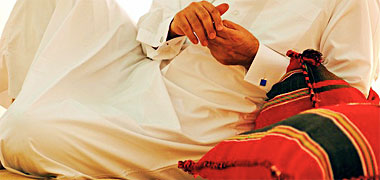
Here to the right is a photograph of a misnad in its original, traditional use in the desert, with a man leaning with his left elbow on it, allowing him to make use of his right hand for receiving qahwa or shy when offered. The pose is the classic way of using the misnad whether in the desert or in a majlis. Although the photo was taken in the desert, you can see by the cufflinks that this is not a badawi but, more likely, a young Qatari enjoying some spare time in the desert.

This photograph illustrates the common way in which the host or owner of the tent will sit with a guest, the guest being the man on the left – to the right of the host – with both men leaning on a misnad. Between and in front of the two men a midkhan or incense burner is temporarily sitting on the floor, an item which is brought to guests who waft the scented smoke from it into their clothing.
The ceiling of a room is preferably high, a view of the entrance and approach to the house are important, and light colours are preferred. Where possible, Qataris will use a baraha or hiyala – external majlis when the weather permits. In the older houses food is served on the ground in the majlis on a circular mat or sufra which is removed at the end of the meal. Most Qataris have tents, although few have the traditional black hair tents of the Badu, preferring the lighter tents or marquees. These tents are stored in the garage and used in the winter months for the benefit of the whole family, particularly at weekends. In fact, there are a number of Qataris who maintain a permanent camp in the winter months with food and provisions being brought out when necessary.
It is still possible to see, in the desert, the stones which were used by the badu to hold down their tents. Over a period of time the badu tended to return to the same areas year after year, using the same flattened or cleared sites and the same stones for weighting. Although there is evidence of primitive dwellings on the Qatar peninsula, in a sense these sites were the first permanent homes within the Qatar peninsula and it is interesting to speculate that the stone houses which evolved near them must have been the first proper settlements of these Badu. Certainly families recognise the terretorial aspects of land in the peninsula.

For the guests and people living in the camps, there is a very simple way of life that hasn’t changed in centuries. Life revolves around the main tent and its fire, though on larger camps the main meals are prepared by the women on their side of the camp or tent. A fire is always present in front of the main tent and it from here that the coffee and tea are prepared. Here you can see the mabkhar in which a’oud, incense, is burned, dalla, typical brass coffee pots, a hawan used in the preparation of the coffee beans, and the brightly coloured, Chinese kettle used for preparing tea.
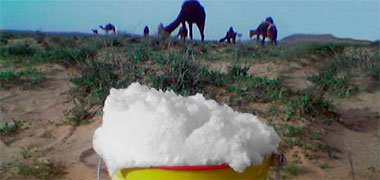
Milk for consumption in the camp is usually provided from the camels, but occasionally from goats kept by the family or tribe. Camel milk is much richer than cows milk and is considered to be a very healthy drink. When first produced it develops a very frothy head to it as can be seen here in its brightly coloured Chinese enamelled bucket. It is considered a mark of hospitality to be offered it as a guest.
Camel saddles
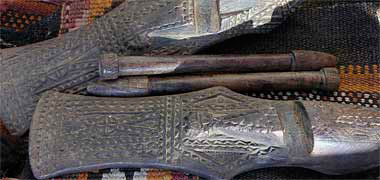
This may not be the best place to locate it, but I want to add a couple of photographs here that show the timber elements of the assembly that attaches to the camel, a riding saddle or hawlaani, shadaad or shidaad. On the face of it a camel saddle may not seem to have much to do with Gulf architecture, however I believe that, like the traditional boats, there is a connection between crafted items such as these and traditional architecture. This is not just a case of their manufacture, but also of their conceptual construction and detailing.
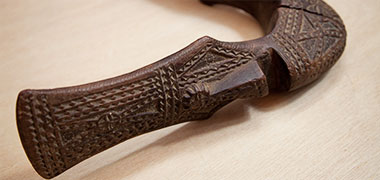
These are relatively small pieces of wood that slot together to form an inverted ‘V’ and are bound with leather strips in order to maintain their necessary shape. The wood sits on top of a padded arrangement which is covered with a woven cloth usually from which tassels hang for decoration, the whole sitting over the hump of the camel and together known as ashiddah.
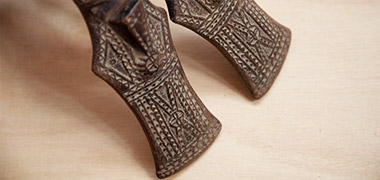
The basic elements from which the camel saddle is constructed are the six wooden pieces, four of which are shown above. There are two pairs of decorated wood pieces known as thuluwf. Each pair meet at the top in a ‘V’ formation, and the two pairs are held together by circular wooden cross pieces, masaleeb, slotted into the angled groove that can be seen on the thuluwf in the photo to the side, and the assemblies bound together.

You can also see, in the photograph above and here, something of the carving that enhances the wooden frame. It is relatively simple, comprising mostly chevron carving in bands tracing the outline of the shaped wood. In this it has similarities to the peripheral carving found in naqsh work though, as you can see, the central panel is completely different from carved naqsh, showing no alteration in the pattern or scale of carving. It is a pattern I associate with the Najd and its decorative work, but I would need to have that ratified.
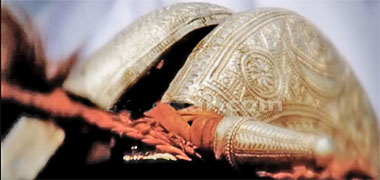
This photo illustrates the top of the thuluwf, this time decorated in beaten silver, and having a silver-pointed masaleeb bound with what appears to be leather thongs, though palm fibres are more usual, to keep the assembly tight. Considerable effort has been made in the covering of the timber elements and their embossed decoration. This patterning reflects the traditional carved naqsh plaster decoration found on traditional buildings.
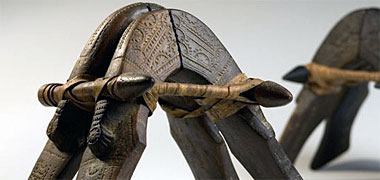
A more complete description of the camel saddle and its elements used in Qatar was to be found on this site, though it seems to have disappeared and the illustrations can’t be found on the Wayback Machine. This illustration was taken from the site but I have not been able to reach the owner. I shall leave the link here in case it reappears because it is far more authoritative than the brief notes placed here.
There is a brief additional note on one of the society pages.
Hunting and falconry

Here is a traditional, if romanticised, view of hunting: the falconer with his hawk on a beautiful horse with a saluqi in attendance.
It is difficult to know exactly where in these papers to discuss hunting and shaheen, falcons, with regard to Arab traditions. There is a considerable amount that should be written but, here, I shall only introduce the subject. For those who wish to learn more there is a significant amount of information elsewhere which they should pursue. I shall write later about the manner in which the hunting season alters the way in which the house is used.
The reason I have included this brief introduction to hawks and hunting here is that falcons seem to me to be strongly bound up with the hospitality for which Arabs are known. In season it is common to see them sitting, each on its wakr, attached by their sbuwq, jesses, and with a burq’a over their heads to keep them calm.
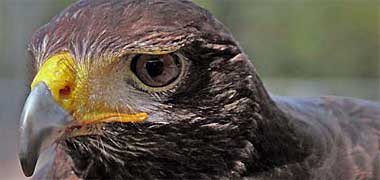
I have used the term, shaheen, to refer to falcons but, specifically, a shaheen is a peregrine falcon – Falco peregrinus, or pilgrim falcon, the female bird generally being the most commonly used in falconry, though the hurr falcon is supposed to be more aggressive and preferred by many. However, it is the common collective name used to refer to hawks, so I shall use it here. The bird shown here is a Harris hawk, one that is a more modern addition to Gulf hunting.
Life in the desert, for the Badu, is one that still holds an attraction for urbanised Arabs. Falcons not only were necessary for adding to the meagre diet of the desert Arab, they represented a continuation of traditional values, the falconer being a figure of prestige in their society. Today falcontry is a sport, albeit an expensive one, but one that draws the urban Arab into the desert for weeks at a time. In season it is common to find hawks in many houses being pampered and exercised while the falconer attempts to find the right balance between maintaining the wildness that keeps it keen for hunting, while taming it enough to return to the lure after flight.
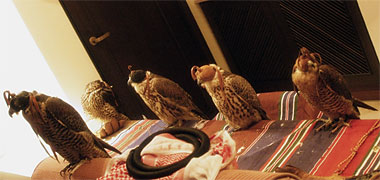
As such, the shaheen is an element of many households, in season, and its role needs to be considered when thinking about the way in which some Arabs live, not just at this time, but all year. Not only are there functional needs relating to the keeping of hawks but, more importantly, the relationship is one that is indicative of many social characteristics and interactions of modern living.
Although the shaheen is the most commonly used in falconry, it is the hurr or Saker falcon that is more highly prized. The hurr is traditionally flown against the houbara bustard, a larger bird, the ensuing battle being one that symbolises much that the desert Arabs prize in their traditions.
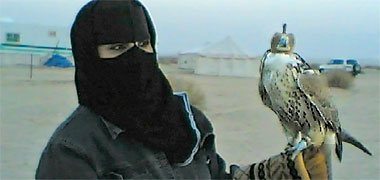
Although men constitute the majority of falconers, women sometimes can be seen with hawks. Here a woman wearing a mask, or batula, typical of those worn by badu women, carries a hooded hawk on a padded gauntlet on her arm.
Winter is the season for hunting with falcons. October to February sees vehicles in the desert with a perch in the back of the car on which sit a number of birds waiting to be exercised. Falcons are expensive and falconry is no longer available to all because of this, though many are involved in their trapping, training and flying. I should add that it is for this reason there is a large market that appears in Autumn, taking the hawks round the houses for sale. There are also concerns arising from over-hunting, breeding and a variety of issues that I’m not qualified to discuss but can easily be researched and followed here and elsewhere. For anybody interested in learning something about the bond between the falcon and falconer, I recommend their reading T. H. White’s ‘The Goshawk’.
Not all hawks are bought from dealers. Some are still trapped for hunting, but this is unusual in the Gulf due to the lack of them there in the wild. Trapping and taking chicks has been carried out for ages. Most of the trapped birds are resourced in Asia and the Indian sub-continent where there is also a tourist market for hunting. Friends also exchange hawks and there is now a captive breeding programme in a number of centres in the Gulf. This latter initiative has brought additional benefits in caring for hawks and their traditional medical problems.
At the end of the hunting season birds that were caught in the wilds are released back into the wild in order to protect and strengthen the breeding cycle. Falconers find it difficult to release their charges as they will have lived with them closely for some time.
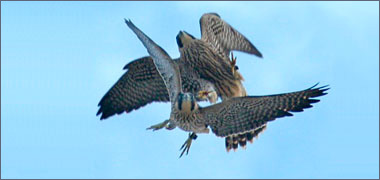
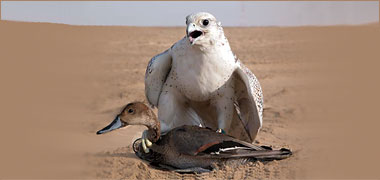
The excitement is easy to see in the chase, the release of the bird against its prey, the stoop as it attacks and the dog-fight that follows. Houbara usually show great skill in flying low to throw the hawk off. While the hawk can move quickly – the shaheen is the fastest living animal, achieving speeds in excess of two hundred kilometres an hour – the houbara is surprisingly manoeuverable for its larger size. Pigeons, which are also used in training, are also very manoeuverable and, at low levels can out-manoeuvre a hawk. In the lower photograph you can see the hawk typically using its wings to shield the duck it has taken.
Many Westerners believe that Arabs consider dogs to be unclean, however this appears not to be so. Picthal’s translation of the Holy Quran says, in Chaper 5, verse 4:
They ask thee (O Muhammad) what is made lawful for them. Say: (all) good things are made lawful for you. And those beasts and birds of prey which ye have trained as hounds are trained, ye teach them that which Allah taught you; so eat of that which they catch for you and mention Allah's name upon it, and observe your duty to Allah. Lo! Allah is swift to take account.
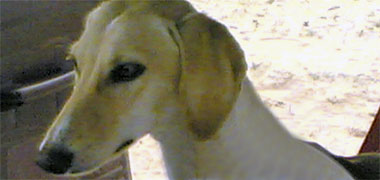

Hence the saluqi, a hunting dog that has been bred by desert hunters for centuries and is as much a part of the household as the shaheen, the two often being seen together both in the house and in the desert. They represent one of the strongest traditions of desert Arabs and their pairing is notable both in the home and outside in the desert, particularly in the way they are worked to bring down prey. In the lower photograph there is one of its most common prey, a desert hare.
Don’t think of either the shaheen or saluqi as pets. They are working animals, perhaps in a similar way to a sheepdog is used in Britain, as an outside animal, not a domesticated inside animal. Saluqi are not fed pet food or its equivalent, but share their masters’ food, mainly the bones, a little camel’s milk and anything they can catch. Think of them as symbols more than pets.
It is in this sense that the hawk is still seen. Those that can own and hunt with them do so, their lives changing during this period of the year, becoming a part of a tradition that goes back centuries. Those that can’t afford to keep them, nevertheless, share an awareness of their heritage and prize the concept of the hawk as a metaphor for some of the nobler elements of their past.
more to be written…
Search the Islamic design study pages
- Introduction
- Arabic / Islamic design
- Arabic / Islamic geometry 01
- Arabic / Islamic geometry 02
- Arabic / Islamic geometry 03
- Arabic / Islamic geometry 04
- Islamic architecture
- Islamic urban design 01
- Islamic urban design 02
- Islamic urban design 03
- Islamic urban design 04
- Islamic urban design 05
- Arabic / Islamic gardens
- Gulf architecture 01
- Gulf architecture 02
- Gulf architecture 03
- Gulf architecture 04
- Gulf architecture 05
- Gulf architecture 06
- Gulf architecture 07
- Gulf architecture 08
- Infrastructure development
- The building industry
- Environmental control
- Perception
- The household on its lot
- A new approach – conceptual
- A new approach – principles
- A new approach – details
- Al Salata al jadida
- Public housing
- Expatriate housing study
- Apartment housing
- Pressures for change
- The State’s administration
- Society 01
- Society 02
- Society 03
- Society 04
- Society 05
- Society 06
- History of the peninsula
- Geography
- Planning 01
- Planning 02
- Population
- Traditional boats
- Boat types
- Old Qatar 01
- Old Qatar 02
- Security
- Protection
- Design brief
- Design elements
- Building regulations
- Glossary
- Glossary addendum
- References
- References addendum
- Links to other sites